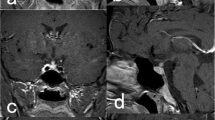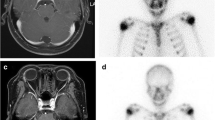Abstract
Erdheim-Chester syndrome is a rare multisystem disease in which progressive xanthogranulomatous infiltration of several tissues are seen. Knee and leg pain are the most common symptoms and bilateral symmetric sclerosis of metaphyseal region of long bones of the lower extremity is typical. Histologically, it resembles Langerhans cell histiocytosis (LCH). However, it is still a matter of discussion whether Erdheim-Chester syndrome is a distinct entity or a type of LCH. The present case is a 46-yr-old man, that presented with signs and symptoms of diabetes insipidus and hypogonadotropic hypogonadism simultaneously. X-rays and bone scintigraphy showed typical and pathogonomic findings of Erdheim-Chester syndrome. Bone biopsy and immunohistochemical staining strongly support the diagnosis of non-Langerhans cell histiocytosis.
Similar content being viewed by others
References
Kenn W., Stabler A., Zachoval R., Zietz C., Raum W., Wittenberg G. Erdheim-Chester disease, a case report and literature overview. Eur. Radiol. 1999, 9: 153–158.
Van der Lee I., Slee P.H., Elbers J.R. A patient with diabetes insipidus and periorbital swelling. Neth. J. Med. 1999, 55: 76–79.
Kenn W., Eck M., Allolio B., et al. Evidence for a disease entity different from Langerhans cell histiocytosis. Hum. Pathol. 2000, 31: 734–739.
Odell W.D., Dogyett S. Xanthoma disseminatum, a rate cause of diabetes insipidus. J. Clin. Endocrinol. Metab. 1991, 76: 777–779.
Chetritt J., Paradis V., Dargere D., et al. Chester-Erdheim disease; a neoplastic disorder. Hum. Pathol. 1999, 30: 1093–1096.
Sisterman R., Katthagen B.D. Erdheim-Chester disease; a rare cause of knee and leg pain. Dr. si@t-online.
Park Y.K., Ryu K.N., Huh B., Kim J.D. Erdheim-Chester disease, a case report. J. Korean Med. Sci. 1999, 14: 323–326.
Spraul C.W., Grossniklaus H.E., Lang G.K. Bilateral adult periocular xanthogranuloma. Klin. Monatsbl. Augenheilkd. 1997, 211: 349–354.
Enriquez R., Cabezuelo J.B., Martinez M., et al. Nephrotic syndrome and amyloidosis in a patient with Erdheim-Chester disease. Nephron 2000, 86: 195–196.
Rush W.I., Andriki J.A., Galateau-Salle F., et al. Pulmonary pathology of Erdheim-Chester disease. Med. Pathol. 2000, 13: 747–754.
Tritos N.A., Weinrib S., Kaye T.B. Endocrine manifestations of Erdheim-Chester disease. J. Intern. Med.1998, 244: 529–535.
Maghnie M., Sommaruga M.H., Beluffi G., Severi F. Role of MR imaging in the evaluation of the functional status of the posterior pituitary gland. Am. J. Neuroradiol. 1993, 14: 1443–1445.
Maghnie M., Cosi G., Genovese E., et al. Central diabetes insipidus in children and young adults. N. Engl. J. Med. 2000, 343: 998–1007.
Tien R., Kucharczyk J., Kucharczyk W. MR imaging of the brain in patients with diabetes insipidus. Am. J. Neuroradiol. 1991, 12: 533–542.
Baylis P.H., Thompsun C.J. Diabetes insipidus and hyperosmolar syndrome. In: Becker K.L. (Ed.) Principle and practice of endocrinology and metabolism. 3rd ed. J.B. Lippincott, Philadelphia, 2001, p. 285.
Author information
Authors and Affiliations
Corresponding author
Rights and permissions
About this article
Cite this article
Khamseh, M.E., Mollanai, S., Hashemi, F. et al. Erdheim-Chester syndrome, presenting as hypogonadotropic hypogonadism and diabetes insipidus. J Endocrinol Invest 25, 727–729 (2002). https://doi.org/10.1007/BF03345108
Accepted:
Published:
Issue Date:
DOI: https://doi.org/10.1007/BF03345108




